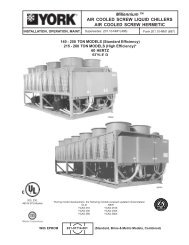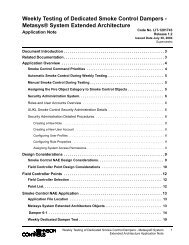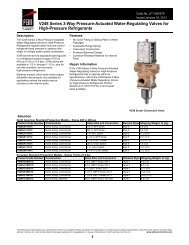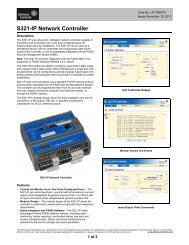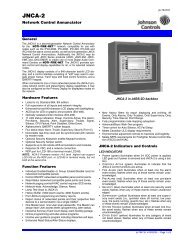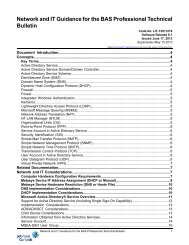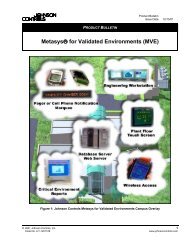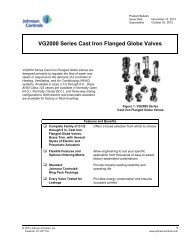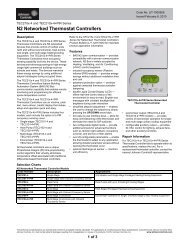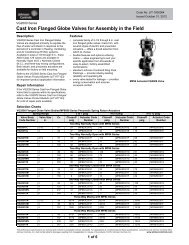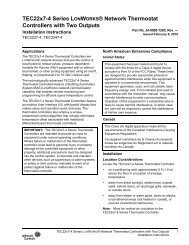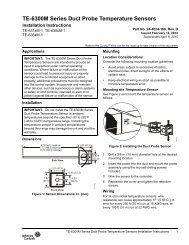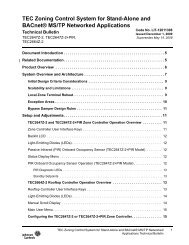YVAA Style A Air-Cooled Screw Liquid Chillers ... - Johnson Controls
YVAA Style A Air-Cooled Screw Liquid Chillers ... - Johnson Controls
YVAA Style A Air-Cooled Screw Liquid Chillers ... - Johnson Controls
You also want an ePaper? Increase the reach of your titles
YUMPU automatically turns print PDFs into web optimized ePapers that Google loves.
FORM 201.28-NM1.1<br />
ISSUE DATE: 8/29/2012<br />
charge refrigerant vapor into the high side of the<br />
system at the charging port on the liquid line. Continue<br />
charging vapor until the pressure is above<br />
the freeze point of the chilled liquid. Once above<br />
the freeze point, liquid can be charged according<br />
to the recommended nameplate charge.<br />
2. Reconnect the water piping to the water boxes.<br />
3. Close the evaporator drain valves and fill the<br />
evaporator with water from the cooling loop.<br />
4. Fill the water loop and check for leaks.<br />
5. Close (0%) the Condenser Drain and Economizer<br />
Valve in the Service Mode. Recycle the chiller<br />
power.<br />
6. Once the system is operating, the charge will<br />
distribute itself throughout the system. Trim the<br />
charge as needed to a level of about midway on<br />
the evaporator sight glass while running full speed<br />
for 15 minutes.<br />
MICROCHANNEL COIL CLEANING<br />
The coil cleaning procedure for microchannel coils is<br />
significantly different than tube and fin type coils. As<br />
such, care must be taken to understand the differences<br />
to avoid damage to the microchannel coil. These differences<br />
require a number of DO NOT’s that must be<br />
observed:<br />
• DO NOT use coil cleaners or any chemical on a<br />
microchannel coil. This can cause severe damage<br />
to the coils.<br />
• DO NOT use a pressure washer to clean the coils.<br />
While it is possible to clean a coil with a pressure<br />
washer, it’s also possible to destroy it.<br />
• DO NOT contact the coil with a hard surface such<br />
as a hose nozzle or metal vacuum nozzle or any<br />
other tool.<br />
SECTION 9 - MAINTENANCE<br />
Microchannel coils tend to accumulate more dirt on<br />
the surface, but less dirt inside the coils, which makes<br />
them easier to clean. Follow the three steps below for<br />
cleaning the coils:<br />
1. Remove surface debris such as dirt, leaves, insects,<br />
fibers, etc. with a vacuum cleaner having<br />
a soft attachment rather than a metal tube. Compressed<br />
air blown from the inside out can also be<br />
used. When brushing debris off the face of the coil<br />
a soft bristle (not wire) brush can be used. Do not<br />
scrape the coil with the vacuum nozzle, air nozzle,<br />
or any other tool.<br />
2. Rinse the coil with tap water. Do not use coil<br />
cleaners. Rinse the coil from the inside out, running<br />
water through every passage in the heat exchanger<br />
surface until it is clean. Microchannel<br />
coils are stronger than conventional tube and fin<br />
coils, but handle them with care, since you can<br />
cause a leak due to impact. Use a gentle spray<br />
from a spray nozzle with a plastic end or put your<br />
finger on the end of the spray nozzle to reduce<br />
impact and provide a gentle spray.<br />
3. Because of the fin geometry, microchannel coils<br />
retain water more than tube and fin style. It is generally<br />
recommended to blow or vacuum out the<br />
rinse water from the coils to speed drying and prevent<br />
water pooling.<br />
Scheduled Maintenance<br />
The maintenance operations detailed in the following<br />
table should be carried out on a regular basis by a suitably<br />
qualified Service Engineer. It should be noted that<br />
the interval necessary between each ‘minor’ and ‘major’<br />
service can vary depending on, for instance, application,<br />
site conditions and expected operating schedule.<br />
Normally a ‘minor’ service should be carried out<br />
every three to six months and a ‘major’ service once a<br />
year. It is recommended that your local <strong>Johnson</strong> <strong>Controls</strong><br />
Service Center is contacted for recommendations<br />
for individual sites.<br />
JOHNSON CONTROLS 131<br />
9



